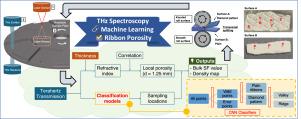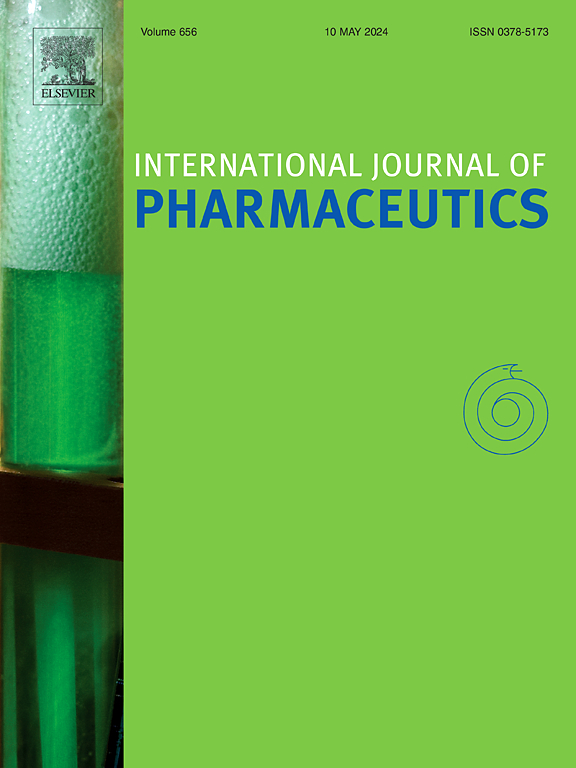Roller compaction: Measuring ribbon porosity by terahertz spectroscopy and machine learning
IF 5.3
2区 医学
Q1 PHARMACOLOGY & PHARMACY
引用次数: 0
Abstract
Roller compaction is a crucial unit operation in pharmaceutical manufacturing, with its ribbon porosity widely recognised as a critical quality attribute. Terahertz spectroscopy has emerged as a fast and non-destructive technique to measure porosity in pharmaceutical products. From a sensing perspective, the irregular shape and uneven surface of fragmented ribbon pieces can affect the accuracy and precision of the measurements, particularly for techniques that probe only a small sampling volume. It is known that the porosity is not uniform within the ribbon structure, with variations expected across the width of the ribbon and in the microstructure corresponding to its surface texture. However, typical pharmaceutical analysis methods, such as envelope density, only report an average bulk porosity, are slow to operate and limited in accuracy. To address this challenge, we developed and trained convolutional neural network models using THz spectra as input to classify four types of topography typically encountered in ribbons: ridge, valley, flat plane and edge points. The classifiers achieved 91% validation accuracy in both identifying outliers and differentiating between ribbons of smooth and knurled surfaces. For the more challenging task of distinguishing between the ridges and valleys of knurled surfaces, an 81% testing accuracy was achieved. Once each measurement is paired with its topography, resolving the density distribution within the sample is possible. This data can be combined to arrive at an average bulk porosity value compatible with conventional pharmaceutical analysis.

压路机压实:通过太赫兹光谱学和机器学习测量带状孔隙率。
辊压是药品生产中的一项关键单元操作,其带状孔隙率被广泛认为是一项重要的质量属性。太赫兹光谱已成为一种快速、非破坏性的技术,可用于测量医药产品中的孔隙率。从传感的角度来看,碎带片的不规则形状和不平整表面会影响测量的准确性和精确度,尤其是对于只探测较小取样体积的技术而言。众所周知,带状结构中的孔隙率并不均匀,在带状结构的整个宽度范围内以及与其表面纹理相对应的微观结构中都会出现变化。然而,典型的药剂分析方法(如包络密度)只能报告平均体积孔隙率,操作缓慢且精度有限。为了应对这一挑战,我们开发并训练了卷积神经网络模型,使用太赫兹光谱作为输入,对带中通常遇到的四种地形进行分类:脊、谷、平面和边缘点。分类器在识别异常值以及区分光滑表面和滚花表面的色带方面都达到了 91% 的验证准确率。在区分滚花表面的脊和谷这一更具挑战性的任务中,测试准确率达到了 81%。将每个测量值与其地形配对后,就可以确定样品内部的密度分布。结合这些数据,就能得出与传统药物分析相匹配的平均容积孔隙率值。
本文章由计算机程序翻译,如有差异,请以英文原文为准。
求助全文
约1分钟内获得全文
求助全文
来源期刊
CiteScore
10.70
自引率
8.60%
发文量
951
审稿时长
72 days
期刊介绍:
The International Journal of Pharmaceutics is the third most cited journal in the "Pharmacy & Pharmacology" category out of 366 journals, being the true home for pharmaceutical scientists concerned with the physical, chemical and biological properties of devices and delivery systems for drugs, vaccines and biologicals, including their design, manufacture and evaluation. This includes evaluation of the properties of drugs, excipients such as surfactants and polymers and novel materials. The journal has special sections on pharmaceutical nanotechnology and personalized medicines, and publishes research papers, reviews, commentaries and letters to the editor as well as special issues.

 求助内容:
求助内容: 应助结果提醒方式:
应助结果提醒方式:


